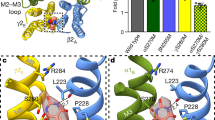Abstract
Two theories of the molecular mechanism of volatile anaesthetic action suggest either that anaesthetics cause a generalized perturbation of neuronal membrane structure, probably through a nonspecific interaction with membrane lipids1,2, or that anaesthetics bind to sets of sites of appropriate molecular dimension on membrane proteins3–5. Based on the recent finding that fluorinated anaesthetics can be observed in animal tissue by 19F nuclear magnetic resonance (19F-NMR) spectroscopy6, we have used 19F-NMR to quantify the interaction between the volatile anaesthetic halothane and rat brain tissue. Steady-state brain halothane concentration was found to be a non-linear function of inspired concentration, with apparent saturation of brain occurring at inspired halothane concentrations above 2.5% by volume. Using a spin-echo pulse sequence it was found that halothane exists in two distinct chemical environments in brain, characterized by different spin-spin –relaxation times (T2), chemical shifts and kinetics of occupancy. Halothane concentration in one of these environments (T2=3.6ms) was saturated at ∼2.5% inspired halothane; occupancy of this environment was found to correlate with the anaesthetic effect of the drug. In the other environment (T2=43 ms), brain halothane concentration was a linear function of inspired concentration. These data suggest the existence of a saturable anaesthetic site for halothane in brain and do not support the concept that anaesthetics act by nonspecific membrane perturbation.
Similar content being viewed by others
References
1. Miller, K. W. & Pang, K. Y. Nature 263, 253–255 (1976). 2. Miller, K. W. Int. Rev. NeurobioL 27, 1–61 (1985). 3. Richards, C. D. et al. Nature 276, 775–779 (1978). 4. Franks, N. P. & Lieb, W. R. Nature 300, 487–493 (1982). 5. Halsey, M. J., Wardley-Smith, B. & Green, C. J. Br. J. Anaesth. 50, 1091–1097 (1978). 6. Wyrwicz, A. M., Li, Y., Schofield, J. C. & Burt, C. T. FEES Lett. 162, 334–338 (1983). 7. Wyrwicz, A. M., Pszenny, M. H., Tillman, P. C., Gordon, R. E. & Martin, P. A. Science 222, 428–430 (1983). 8. Deutsch, S. et al. Anesthesiology 23, 631–638 (1962). 9. Eger, E. I. Ill et al. Anesthesiology 32, 396–409 (1970). 10. Void, R. L., Waugh, J. S., Klein, M. P. & Phelps, D. E. / chem. Phys. 48, 3831–3832 (1968). 11. Meiboom, S. & Gill, D. Rev. Sci. Instrum. 29, 688–691 (1958). 12. Resing, H. A. & Garroway, A. N. in Magnetic Resonance in Colloid and Interface Science (eds Resing, H. A. & Wade, C. G.) 516–529 (Am. Chem. Soc., Washington, 1976). 13. Koehler, L. S., Fossel, E. T. & Koehler, K. A. Biochemistry 16, 3700–3707 (1977). 14. Evers, A. S., Elliot, W. J., Lefkowith, J. B. & Needleman, P. / din. Invest. 77, 1028–1038 (1986). 15. Heavner, J. E., Friedhoff, J. & Haschke, R. Anesthesiology 45, 654–655 (1976). 16. Lowry, O. H., Hastings, A. B., McCay, C. M. & Brown, A. N. / Geront. 1, 345–357 (1946).
Author information
Authors and Affiliations
Rights and permissions
About this article
Cite this article
Evers, A., Berkowitz, B. & d'Avignon, D. Correlation between the anaesthetic effect of halothane and saturable binding in brain. Nature 328, 157–160 (1987). https://doi.org/10.1038/328157a0
Received:
Accepted:
Issue Date:
DOI: https://doi.org/10.1038/328157a0
- Springer Nature Limited
This article is cited by
-
Uptake and elimination of sevoflurane in rabbit tissues — anin vivo magnetic resonance spectroscopy study
Canadian Journal of Anesthesia/Journal canadien d'anesthésie (2000)
-
Effect of inhalation anesthetics on swimming activity of artemia salina
Journal of Anesthesia (1991)
-
Halothane and anaesthesia
Nature (1990)
-
NMR studies of drug metabolism and disposition
European Journal of Drug Metabolism and Pharmacokinetics (1990)
-
Correction: Correlation between the anaesthetic effect of halothane and saturable binding in brain
Nature (1989)





